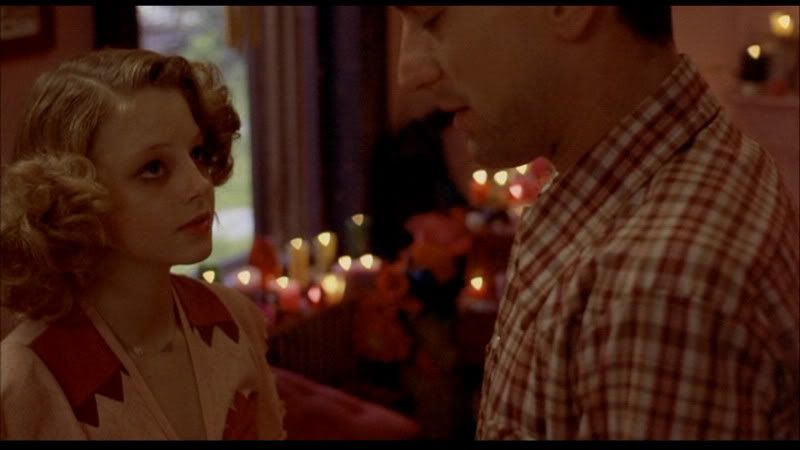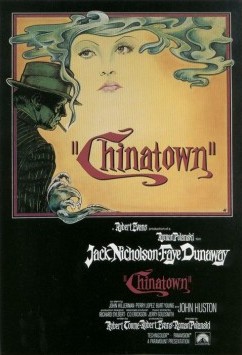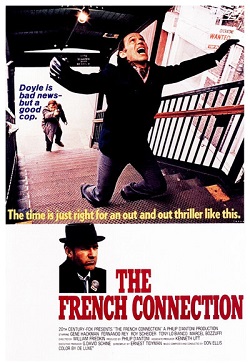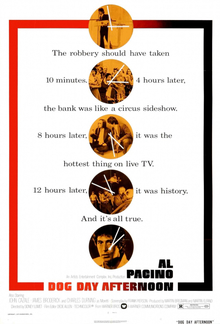 What is there left to say about Martin Scorsese's seminal 1976 Taxi Driver that hasn't been said already? Not much. Since its inclusion as 47th greatest American movie of all time on AFI's trite "100 Years...100 movies" list, Scorsese's masterpiece has been consistently praised as that 70's classic--a label that, although certainly true, misconstrues the rather modest scope of the film. In its seedy, gritty presentation, Taxi Driver is, without a doubt, an essential 70's movie. Like Carol Reed's classic 1949 The Third Man, Scorsese's film arises more in everything that is occurring around its main character, Robert De Niro's Travis Bickle, a loner who takes up the job of a taxi driver in order to cope with his chronic insomnia. Scorsese's film becomes a much more intimate film than immediately realized--a film essential not for its grand scope but its modest pitting of a man caught in the masses of a society he cannot stand.
What is there left to say about Martin Scorsese's seminal 1976 Taxi Driver that hasn't been said already? Not much. Since its inclusion as 47th greatest American movie of all time on AFI's trite "100 Years...100 movies" list, Scorsese's masterpiece has been consistently praised as that 70's classic--a label that, although certainly true, misconstrues the rather modest scope of the film. In its seedy, gritty presentation, Taxi Driver is, without a doubt, an essential 70's movie. Like Carol Reed's classic 1949 The Third Man, Scorsese's film arises more in everything that is occurring around its main character, Robert De Niro's Travis Bickle, a loner who takes up the job of a taxi driver in order to cope with his chronic insomnia. Scorsese's film becomes a much more intimate film than immediately realized--a film essential not for its grand scope but its modest pitting of a man caught in the masses of a society he cannot stand. Andrei Tarkovsky's 1972 Solaris resurrects the essential ideas of transformative cinema--cinema as means to find something. The story of scientists haunted by their stay in space--a purgatory where time and human constructs seem irrelevant--the film, like its characters, is very much trying to find its place somewhere or as something. There's no denying the slow start to Tarkovsky's film, and although what we find may, in the end, be nothing at all, Solaris does not care; it's a film conscious of its lack of shape.
Andrei Tarkovsky's 1972 Solaris resurrects the essential ideas of transformative cinema--cinema as means to find something. The story of scientists haunted by their stay in space--a purgatory where time and human constructs seem irrelevant--the film, like its characters, is very much trying to find its place somewhere or as something. There's no denying the slow start to Tarkovsky's film, and although what we find may, in the end, be nothing at all, Solaris does not care; it's a film conscious of its lack of shape.
Rainer Werner Fassbinder's 1975 Ali: Fear Eats the Soul is many things, an intimate story of two people caught in the gaze--literally--of a heinous societal tension, a film of grand intimacy in the tradition of Douglas Sirk, yet one thing it is not is subtle. It's in the way the film is shot, or even in the way Fassbinder's characters speak, or the way they look. Their gazes are always documented, Fassbinder shows us, and, like them, Ali: Fear Eats the Soul is timeless in its documentation of a society caught by hatred and malaise.
 Like Taxi Driver, the brilliance in Sidney Lumet's 1973 Dog Day Afternoon is not in the standard cops-and-robbers tale it presents--it's in its setting and characterization. The brilliant moments in the film occur as a result of a straightforward plot set-up: take Charles Durning's negotiator, for instance, who is hilarious because of his incompetence; or how both Sonny (Al Pacino)and Sal realize their plan to escape is nothing if not naive; or, how most of all, crowds of people stand outside the bank cheering every time Sonny comes out to negotiate. Moments like these shape the film's amazing finale: that a film like this could never leave New York.
Like Taxi Driver, the brilliance in Sidney Lumet's 1973 Dog Day Afternoon is not in the standard cops-and-robbers tale it presents--it's in its setting and characterization. The brilliant moments in the film occur as a result of a straightforward plot set-up: take Charles Durning's negotiator, for instance, who is hilarious because of his incompetence; or how both Sonny (Al Pacino)and Sal realize their plan to escape is nothing if not naive; or, how most of all, crowds of people stand outside the bank cheering every time Sonny comes out to negotiate. Moments like these shape the film's amazing finale: that a film like this could never leave New York.
Dario Argento's 1977 Suspiria is a visual feast, an incredibly realized, insanely artful evocation that masks its incredible aesthetics in a self-reflexive and even campy development of plot and character. Anyone, I think, who complains about its hilarious writing and campy cookie-cutter characters is missing the point; Suspiria's magistery is in its images, and their construction. Argento's mise-en-scene is always manipulated, exploited, so to speak, to create his synthetic over-glow of haunting red colors or overtones, a film all about affecting the aesthetic response, a stab at the viewer to respond to what's going on no matter what.
 Around the late seventies, when Hollywood blockbusters emerges and films like Annie Hall, Star Wars, Close Encounters of the Third Kind, and Saturday Night Fever ruled the age, Charles Burnett silently crafted his 1977 Killer of Sheep, his thesis film for UCLA. Thirty years it has eluded us -- that is, until now. The result, although aging those thirty-years, is a masterpiece; an authentic and one of a kind piece of raw American poetry that simply and silently observes life in the Watts ghetto of Los Angeles.
Around the late seventies, when Hollywood blockbusters emerges and films like Annie Hall, Star Wars, Close Encounters of the Third Kind, and Saturday Night Fever ruled the age, Charles Burnett silently crafted his 1977 Killer of Sheep, his thesis film for UCLA. Thirty years it has eluded us -- that is, until now. The result, although aging those thirty-years, is a masterpiece; an authentic and one of a kind piece of raw American poetry that simply and silently observes life in the Watts ghetto of Los Angeles. Terrence Malick's 1978 Days of Heaven is a rapturous focus on the power of images in film. The story of a cross-country love of two workers who fall into some deep shit with their employer, the film is all about sequencing, the power of images in order--or out of order--and how they evoke love, fear, hatred, and jealousy. The film is as heavenly as its title.
Terrence Malick's 1978 Days of Heaven is a rapturous focus on the power of images in film. The story of a cross-country love of two workers who fall into some deep shit with their employer, the film is all about sequencing, the power of images in order--or out of order--and how they evoke love, fear, hatred, and jealousy. The film is as heavenly as its title. Widely regarded as Ousmane Sembene's finest achievement, Xala (1975) is a cutting morality tale that equally blames the corruption of Senegal's sociopolitical environment on Euro-centricity and African auto-destruction. As hung as a rope, Semebene's camera traces a group of black individuals attain political power via an absurdist coup, an occurence that disrupts routine in community. The film is not unlike an African Fassbinder film though its rawness certainly is as, or more, haunting.
Widely regarded as Ousmane Sembene's finest achievement, Xala (1975) is a cutting morality tale that equally blames the corruption of Senegal's sociopolitical environment on Euro-centricity and African auto-destruction. As hung as a rope, Semebene's camera traces a group of black individuals attain political power via an absurdist coup, an occurence that disrupts routine in community. The film is not unlike an African Fassbinder film though its rawness certainly is as, or more, haunting. If Ali: Fear Eats the Soul was a direct exploration of a society plagued by myopic racism, then there's no question that Rainer Werner Fassbinder's 1975 Mother Küsters Goes to Heaven is its political counterpart, a film brilliant in its political analysis and two sided approach. The story of a woman whose Husband commits suicide after being fed up with his job at a factory for unknown reasons, the film is very aware of what is going around it, yet trying to, like Solaris find an answer. In its canny depiction of the petty bourgeois political climate, Fassbinder's criticism is pitch-perfect.
If Ali: Fear Eats the Soul was a direct exploration of a society plagued by myopic racism, then there's no question that Rainer Werner Fassbinder's 1975 Mother Küsters Goes to Heaven is its political counterpart, a film brilliant in its political analysis and two sided approach. The story of a woman whose Husband commits suicide after being fed up with his job at a factory for unknown reasons, the film is very aware of what is going around it, yet trying to, like Solaris find an answer. In its canny depiction of the petty bourgeois political climate, Fassbinder's criticism is pitch-perfect.
William Friedkin's 1971 classic The French Connection is a film about spaces, a work that uses, unlike Dog Day Afternoon, New York City as a constant setting to frame the movements of detective Jimmy Doyle (Gene Hackman) as he tracks French drug traffickers across the city. The most famous sequence in the film, the chase scene in which Hackman chases one of the drug traffickers (Marcel Bozzufi, the famous killer in Costa Gavras' Z), is remarkable for its pacing but also the tension that arises out of its background setting--the way, for instance, the claustrophobia of the Subway manifests itself in hand-held shots, or the way Hackman looks up at Bozzufi as he attempts to assassinate him from a New York building. The film's brilliance is here, in the tension between setting and narrative. The French Connection is, after all, nothing if not an essential New York movie.
 Werner Herzog's 1974 Aguirre: The Wrath of God has to be one of the greatest films ever made, though its presence here is necessary: everything about this revolutionary film epitomizes the burgeoning construction of 70's filmmaking. Controversial actor Klaus Kinski plays Aguirre, the gold-crazed deserter of Pizarro's exploration of Peru; through mountains, fog, rivers, and heat, Herzog's camera and Popol Vuh's score trace their failed conquest, a feat of ambient filmmaking that evokes the hazy failure and misunderstanding of colonizers in the new world. If you do not get chills at the last shot, then there is something wrong with your film sensibilities.
Werner Herzog's 1974 Aguirre: The Wrath of God has to be one of the greatest films ever made, though its presence here is necessary: everything about this revolutionary film epitomizes the burgeoning construction of 70's filmmaking. Controversial actor Klaus Kinski plays Aguirre, the gold-crazed deserter of Pizarro's exploration of Peru; through mountains, fog, rivers, and heat, Herzog's camera and Popol Vuh's score trace their failed conquest, a feat of ambient filmmaking that evokes the hazy failure and misunderstanding of colonizers in the new world. If you do not get chills at the last shot, then there is something wrong with your film sensibilities. Up until 1979, Rainer Werner Fassbinder's films were mostly political or social analyses on West German sociopolitical malaise. His 1979 masterpiece, In a Year of 13 Moons, is a very personal film, a work so personal in its catharsis and in the way its aesthetics are manifested in its catharsis that many of its haunting voice-overs are nothing if not unforgettable. The story of a transsexual misplaced in German society, and an ode to his lover that commited suicide in 1978, In a Year of 13 Moons may be Fassbinder's greatest achievement, if only because the film's kitchen-sink melodrama collectively addresses the domestic, cultural, psychological, spiritual, and existential hang-ups of the human condition his others films addressed individually.
Up until 1979, Rainer Werner Fassbinder's films were mostly political or social analyses on West German sociopolitical malaise. His 1979 masterpiece, In a Year of 13 Moons, is a very personal film, a work so personal in its catharsis and in the way its aesthetics are manifested in its catharsis that many of its haunting voice-overs are nothing if not unforgettable. The story of a transsexual misplaced in German society, and an ode to his lover that commited suicide in 1978, In a Year of 13 Moons may be Fassbinder's greatest achievement, if only because the film's kitchen-sink melodrama collectively addresses the domestic, cultural, psychological, spiritual, and existential hang-ups of the human condition his others films addressed individually. David Lynch would continue to make films into the 80's and 90's, but nothing is quite like his 1977 opus Eraserhead. A man gone batshit wouldn't really summarize this film, though it certainly sets the context for which Lynch explores his main's character's psyche, a raw collage of different images, sounds, all exuded in a severe, unflinching darkness. The film is short but its images are not: experimental as hell, the film is nothing is not a 70's movie.
David Lynch would continue to make films into the 80's and 90's, but nothing is quite like his 1977 opus Eraserhead. A man gone batshit wouldn't really summarize this film, though it certainly sets the context for which Lynch explores his main's character's psyche, a raw collage of different images, sounds, all exuded in a severe, unflinching darkness. The film is short but its images are not: experimental as hell, the film is nothing is not a 70's movie. Shohei Imamura is unlike many Japanese filmmakers in the 70's, and his 1979 Vengeance is Mine is a testament to how the gritty 70's cinema of the West manifested itself into Japanese filmmaking and culture. The fact-based story of the seventy-eight-day killing spree of a remorseless man from a devoutly Catholic family into a cold and perverse portrait of the primitive coexisting with the modern, the film is itself modern and its aesthetics quite 70's. The juxtaposition creates a masterpiece of form and content.
Shohei Imamura is unlike many Japanese filmmakers in the 70's, and his 1979 Vengeance is Mine is a testament to how the gritty 70's cinema of the West manifested itself into Japanese filmmaking and culture. The fact-based story of the seventy-eight-day killing spree of a remorseless man from a devoutly Catholic family into a cold and perverse portrait of the primitive coexisting with the modern, the film is itself modern and its aesthetics quite 70's. The juxtaposition creates a masterpiece of form and content. Luis Buñuel died in 1983, and although the majority of his masterworks were made in the middle of his oeuvre, his last 3 films share some of the bitingly keen and avant-garde qualities of his previous films. His 1973 The Discreet Charm of the Bourgeoisie certainly possesses the wicked humour and incredible observation of something like Belle Du Jour, as he traces the story of six upper-class dolts who are in constant motion but find their every attempt to stuff their stomachs frustrated by a series of strange disruptions and misunderstandings. It is a criticism of the bourgeoisie, no question, though its aesthetics are as smooth and perfect as ever. In the vital political scene of the 70's, Buñuel's film certainly fits in.
Luis Buñuel died in 1983, and although the majority of his masterworks were made in the middle of his oeuvre, his last 3 films share some of the bitingly keen and avant-garde qualities of his previous films. His 1973 The Discreet Charm of the Bourgeoisie certainly possesses the wicked humour and incredible observation of something like Belle Du Jour, as he traces the story of six upper-class dolts who are in constant motion but find their every attempt to stuff their stomachs frustrated by a series of strange disruptions and misunderstandings. It is a criticism of the bourgeoisie, no question, though its aesthetics are as smooth and perfect as ever. In the vital political scene of the 70's, Buñuel's film certainly fits in. Dario Argento's *1982* Tenebre is as late 70's a film as Argento ever made. Everything from Goblins' disco-y late 70's score to Argento's subjective camera have Suspiria's vibe all over them. The story of an American writer in Rome whose new crime novel is used as a base for similar killings, the film is scary as fuck yet insanely self-reflexive. Most of all, it's disco-y and jazzy -- it's no coincidence that Argento's films after the 80's declined; the man is a giallo 70's filmmaker, and Tenebre is perhaps his best film.
Dario Argento's *1982* Tenebre is as late 70's a film as Argento ever made. Everything from Goblins' disco-y late 70's score to Argento's subjective camera have Suspiria's vibe all over them. The story of an American writer in Rome whose new crime novel is used as a base for similar killings, the film is scary as fuck yet insanely self-reflexive. Most of all, it's disco-y and jazzy -- it's no coincidence that Argento's films after the 80's declined; the man is a giallo 70's filmmaker, and Tenebre is perhaps his best film. Ingmar Bergman's 1978 Autumn Sonata is, like In a Year of 13 moons, a very personal film, and so it is fitting that much of Bergman's post-auteristic filmmaking recedes to form a more personal portrait. Autumn Sonata is my personal favorite Bergman film, if only for how personal it itself is: in its perfect albeit tragic portrait of a family torn by the past, a new level is reached in form and content. Even the film's final sequence is loaded with a new, restrained type of emotional catharsis--a passion that manifests itself gently, slowly building, throughout most of the film.
Ingmar Bergman's 1978 Autumn Sonata is, like In a Year of 13 moons, a very personal film, and so it is fitting that much of Bergman's post-auteristic filmmaking recedes to form a more personal portrait. Autumn Sonata is my personal favorite Bergman film, if only for how personal it itself is: in its perfect albeit tragic portrait of a family torn by the past, a new level is reached in form and content. Even the film's final sequence is loaded with a new, restrained type of emotional catharsis--a passion that manifests itself gently, slowly building, throughout most of the film. One of Rainer Werner Fassbinder's towering masterworks as well as one of his essential deconstructions on the role of sexuality in the Western world, Fox and His Friends (1974) traces a young circus worker (Fassbinder himself) who falls into the pit of a bourgeois lifestyle after meeting Eugen, a rich business man who uses Fox for his money. Class and sexuality mix, Fassbinder observes, to form one detestable, meta-class--a ruling class filled with hate and oppression. Fox and His Friends documents this class pitch-perfectly.
One of Rainer Werner Fassbinder's towering masterworks as well as one of his essential deconstructions on the role of sexuality in the Western world, Fox and His Friends (1974) traces a young circus worker (Fassbinder himself) who falls into the pit of a bourgeois lifestyle after meeting Eugen, a rich business man who uses Fox for his money. Class and sexuality mix, Fassbinder observes, to form one detestable, meta-class--a ruling class filled with hate and oppression. Fox and His Friends documents this class pitch-perfectly. Robert Altman's anti-western McCabe & Mrs. Miller (1971), like Thieves Like Us, is so self-contained and effortlessly executed to be read as a deliberate exercise in genre deconstruction. Like all great Altman films, the only way to enter McCabe & Mrs. Miller, the story of two lovers in the west, is by eavesdropping on the film's text via Altman's familiar use of zoom and overlapping dialogue. With Leonard Cohen's ethereal songs and Vilmos Zsigmond's timeless camerawork, Altman evokes a tragic western landscape on the brink of economic and spiritual exhaustion.
Robert Altman's anti-western McCabe & Mrs. Miller (1971), like Thieves Like Us, is so self-contained and effortlessly executed to be read as a deliberate exercise in genre deconstruction. Like all great Altman films, the only way to enter McCabe & Mrs. Miller, the story of two lovers in the west, is by eavesdropping on the film's text via Altman's familiar use of zoom and overlapping dialogue. With Leonard Cohen's ethereal songs and Vilmos Zsigmond's timeless camerawork, Altman evokes a tragic western landscape on the brink of economic and spiritual exhaustion. The question is simple: how can one not include Roman Polanski's classic 1974 Chinatown on a shitty list like this? Frankly, I could not help myself. Everything in Polanski's masterpiece, from its gliding camera and jazzy ambiance, its classic character developments to the wrenching, chill-inducing final sequence is flawless. It's not an unknown film, I'm aware, but it is a film that, while alive, every human being should watch. See it.
The question is simple: how can one not include Roman Polanski's classic 1974 Chinatown on a shitty list like this? Frankly, I could not help myself. Everything in Polanski's masterpiece, from its gliding camera and jazzy ambiance, its classic character developments to the wrenching, chill-inducing final sequence is flawless. It's not an unknown film, I'm aware, but it is a film that, while alive, every human being should watch. See it.






